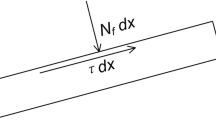Abstract
Vibration in pipeline system is a usual occurrence in industrial equipments. A transient fluid-structure coupling method, with data exchange between fluid and structure, is used in this paper to study the pipeline self-excited vibration under the interaction between pipe structure and internal airflow. The coupling method is based on large eddy simulation and dynamic mesh. Structured grids are used to make the displacements of grid nodes accurately calculated at each time step. The results of transient calculation show that when there is no external excitation and the given inlet mass flow rate is constant, the vibration and the pressure fluctuation of pipeline will occur, and the frequencies are close to the natural frequencies of structure and the acoustic frequencies. Furthermore, the higher the pressure inside the pipeline, the more intense the vibration and pressure fluctuation of the pipeline. By comparison of the experimental and numerical results, it is suggested that the calculation results of fluid-structure coupling are consistent with the practical situation, which indicates that the coupling method is effective and reasonable, and may be used in engineering practice.




















Similar content being viewed by others
References
Rütten F, Meinke M, Schröder W (2001) Large-eddy simulations of 90° pipe bend flows. J Turbul 2:3
Sakowitz A, Mihaescu M, Fuchs L (2013) Effects of velocity ratio and inflow pulsations on the flow in a t-junction by large eddy simulation. Comput Fluids 88:374–385
Simoneau JP, Champigny J, Gelineau O (2010) Applications of large eddy simulations in nuclear field. Nucl Eng Des 240(2):429–439
Ming T, Zhao J (2012) Large-eddy simulation of thermal fatigue in a mixing tee. Int J Heat Fluid Flow 37:93–108
Tunstall R, Laurence D, Prosser R et al (2016) Large eddy simulation of a t-junction with upstream elbow: the role of dean vortices in thermal fatigue. Appl Therm Eng 107:672–680
Wiggert DC, Otwell RS, Hatfield FJ (1985) The effect of elbow restraint on pressure transients. J Fluids Eng 107(3):402–406
Wiggert DC, Hatfield FJ, Stuckenbruck S (1987) Analysis of liquid and structural transients in piping by the method of characteristics. J Fluids Eng 109(2):161–165
Erath W, Nowotny B, Maetz J (1999) Modelling the fluid structure interaction produced by a waterhammer during shutdown of high-pressure pumps. Nucl Eng Des 193(3):283–296
Tijsseling AS, Lavooij CSW (1990) Waterhammer with fluid-structure interaction. Appl Sci Res 47(3):273–285
Sreejith B, Jayaraj K, Ganesan N et al (2004) Finite element analysis of fluid–structure interaction in pipeline systems. Nucl Eng Des 227(3):313–322
Menter F, Sharkey P, Yakubov S et al (2006) Overview of fluid-structure coupling in ANSYS-CFX. 25th International Conference on Offshore Mechanics and Arctic Engineering
Vardy AE, Fan D, Tijsseling AS (1996) Fluid-structure interaction in a t-piece pipe. J Fluids Struct 10(7):763–786
Tijsseling AS, Vardy AE, Fan D (1996) Fluid-structure interaction and cavitation in a single-elbow pipe system. J Fluids Struct 10:395–420
Tijsseling AS (1996) An overview of fluid-structure interaction experiments in single-elbow pipe systems. J Zhejiang Univ Sci A 20(4):233–242
Ziada S, Mclaren KW, Li Y (2009) Flow-acoustic coupling in t-junctions: effect of t-junction geometry. J Press Vessel Technol 131(4):041302
Duan GB, Liu ZM, Chen GL (2010) Experimental investigation of gas-solid two-phase flow in y-shaped pipeline. Adv Powder Technol 21(4):468–476
Pittard MT, Evans RP, Maynes RD et al (2004) Experimental and numerical investigation of turbulent flow induced pipe vibration in fully developed flow. Rev Sci Instrum 75(7):2393
Pittard MT, Blotter JD (2003) Numerical modeling of LES based turbulent flow induced vibration. ASME International Mechanical Engineering Congress & Exposition
Nilsson P, Lillberg E, Wikström N (2012) LES with acoustics and FSI for deforming plates in gas flow. Nucl Eng Des 253:387–395
Selvam PK, Kulenovic R, Laurien E (2015) Large eddy simulation on thermal mixing of fluids in a t-junction with conjugate heat transfer. Nucl Eng Des 284:238–246
Wu J, Li C, Zheng S et al (2019) Study on fluid-structure coupling vibration of compressor pipeline. Shock Vib (in press)
Wu J, Zheng S (2019) Field measurement and numerical study of the vibration in the pipeline of centrifugal compressor. J Press Vessel Technol 141(5):051602
Li M, Gu C, Pan X et al (2016) A new dynamic mesh algorithm for studying the 3D transient flow field of tilting pad journal bearings. Proc Inst Mech Eng J J Eng Tribol 230(12):1470–1482
Funding
This research was supported and funded by National Key Research and Development Program of China (No. 2016YFC0801200).
Author information
Authors and Affiliations
Corresponding author
Additional information
Publisher’s note
Springer Nature remains neutral with regard to jurisdictional claims in published maps and institutional affiliations.
Rights and permissions
About this article
Cite this article
Wu, J., Zheng, S., Wang, C. et al. Study on pipeline self-excited vibration using transient fluid-structure coupling method. Int J Adv Manuf Technol 107, 4055–4068 (2020). https://doi.org/10.1007/s00170-020-04983-x
Received:
Accepted:
Published:
Issue Date:
DOI: https://doi.org/10.1007/s00170-020-04983-x




